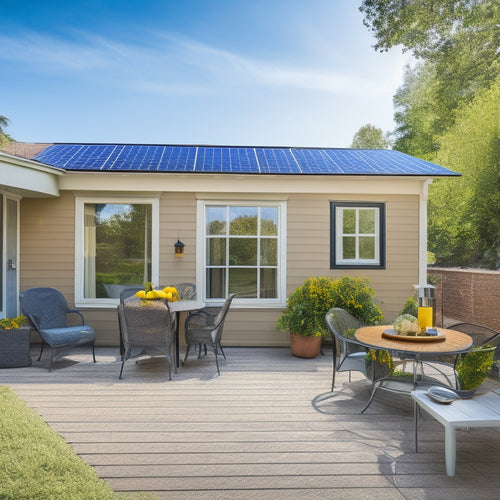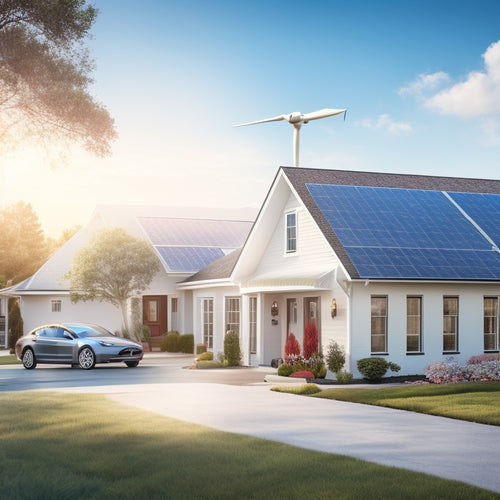The Handyman's Guide to Using Solar Power for Everyday Tools
Share
As a handyman, you know the importance of staying powered up on the job site. Going solar is a game-changer, reducing your carbon footprint while keeping your tools charged and ready. Selecting the right solar panels, compatible power tools, and building a portable solar kit can seem intimidating, but with the right know-how, you'll be harnessing clean energy in no time. From maximizing energy storage to overcoming common solar challenges, you'll be well on your way to a more sustainable work routine. Now, get ready to take your solar-powered toolbox to the next level and discover the endless possibilities.
Key Takeaways
• Selecting the right solar panels and power tools is crucial, considering factors like durability, warranty, efficiency, and certifications.
• Customizing solar kits with high-efficiency panels, charge controllers, deep cycle batteries, and inverters optimizes energy conversion for tools.
• Effective energy storage and management involves optimizing charging cycles, monitoring battery life, and adjusting schedules for maximum energy output.
• Solar power can overcome challenges like shade and cloudy days by incorporating energy storage solutions, tracking systems, and smart energy management.
• Solar-powered toolboxes provide a reliable, sustainable, and cost-effective energy source for handymen, ideal for remote job sites, disaster response, and off-grid energy solutions.
Why Solar Power Matters Today
What would happen if you could harness the energy of the sun to power your daily life, reducing your reliance on fossil fuels and shrinking your carbon footprint?
You'd be contributing to a cleaner, more sustainable future. Climate change is one of the most pressing issues of our time, and switching to solar power is a vital step in mitigating its effects.
By harnessing the sun's energy, you'll not only reduce your carbon emissions but also enhance energy security. You'll no longer be reliant on finite fossil fuels, which are a major contributor to climate change.
Solar power is a clean, renewable energy source that's available everywhere.
By making the shift to solar, you'll be doing your part to combat climate change and guarantee a sustainable future.
You'll also be contributing to energy security, reducing our dependence on imported fuels and enhancing energy independence.
The benefits of solar power are undeniable, and by embracing this technology, you'll be part of a global movement towards a cleaner, more sustainable world.
Choosing the Right Solar Panels
As you prepare to harness the power of the sun, selecting the right solar panels for your needs is vital to maximizing energy output and minimizing costs.
When choosing solar panels, you'll want to weigh several key factors to guarantee you're getting the most out of your investment.
Panel Durability: Look for panels with a durable design and high-quality materials that can withstand the elements and last for years to come.
Warranty Options: Make sure to choose a manufacturer that offers an extensive warranty that covers repairs and replacements for a significant period of time.
Efficiency Ratings: Consider panels with high efficiency ratings to maximize energy output and minimize space requirements.
Certifications and Compliance: Verify that your chosen panels meet industry standards and comply with local regulations.
Selecting Compatible Power Tools
When selecting power tools to pair with your solar panels, consider the Tool Weight, as it directly affects the tool's portability and maneuverability. A heavier tool may require more energy, which can drain your solar power supply quickly.
Opt for tools with balanced weight distribution and ergonomic design to promote comfortable handling.
Cordless options are ideal for solar-powered tools, as they eliminate the need for cumbersome cords and reduce energy loss.
Look for tools with high-capacity batteries and efficient charging systems to maximize your solar power output. Additionally, consider tools with adjustable speed settings and variable torque control to optimize energy consumption.
Building a Portable Solar Kit
Building a portable solar kit requires assembling a carefully selected set of components that can efficiently harness and convert sunlight into electrical energy on-the-go. As a handyman, you want a setup that's reliable, efficient, and tailored to your specific needs. That's where kit customization comes in. By choosing the right components, you can create a solar suitcase that's perfect for your projects.
You'll need the following essential components to get started:
-
Solar Panels: High-efficiency panels that can generate power in varying sunlight conditions.
-
Charge Controller: A device that regulates the flow of energy from the panels to your battery.
-
Deep Cycle Battery: A reliable battery designed to store excess energy for later use.
- Inverter: A device that converts DC power from your battery to AC power for your tools.
Maximizing Energy With Battery Storage
As you shift to solar power, you'll want to maximize your energy output by optimizing your battery storage.
This involves fine-tuning your charging cycle efficiency, setting up reliable power backup systems, and optimizing energy harvesting to guarantee a consistent power supply.
Charging Cycle Efficiency
Maximizing energy with battery storage requires optimizing your charging cycle efficiency, which directly impacts the overall performance of your solar-powered tools. As you strive to get the most out of your solar setup, understanding charging cycle efficiency is crucial.
To optimize your charging cycle, consider the following:
-
Monitor your cycle life expectancy: Keep track of how many charge cycles your batteries can handle before their capacity starts to degrade.
-
Mitigate energy loss: Minimize energy loss during charging and discharging by using high-quality cables, connectors, and battery management systems.
-
Adjust your charging schedule: Charge your batteries during off-peak hours to reduce strain on the grid and optimize energy absorption.
- Select the right battery type: Choose batteries with high charging cycle efficiency, such as lithium-ion or lead-acid batteries, to ensure optimal performance.
Power Backup Systems
Your power backup system's reliability hinges on its ability to store excess energy generated by your solar panels during the day, allowing you to tap into it when the sun goes down or during outages. A well-designed power backup system guarantees system reliability and provides emergency preparedness. To maximize energy storage, you'll need a battery bank that can store excess energy generated during the day.
| Battery Type | Capacity (Wh) | Cycle Life |
| Lead-Acid | 200-400 Wh | 200-300 cycles |
| Lithium-Ion | 400-800 Wh | 500-700 cycles |
| Deep Cycle | 800-1200 Wh | 700-1000 cycles |
When selecting a battery bank, consider factors such as capacity, cycle life, and depth of discharge. A higher capacity battery bank can provide more power during outages, while a longer cycle life supports your system's reliability over time. By choosing the right battery bank for your power backup system, you'll be well-prepared for emergency situations and can rest assured that your tools will keep running smoothly.
Energy Harvesting Optimization
You can substantially enhance your solar power system's efficiency by optimizing energy harvesting through strategic battery storage and management. By doing so, you'll be able to maximize energy output and reduce energy waste.
To achieve this, focus on peak shaving, which involves reducing energy consumption during peak hours, and energy tracking, which helps you monitor your energy usage.
Monitor your energy usage: Keep track of your energy consumption patterns to identify areas of improvement.
Verify battery storage: Guarantee your battery storage system is properly sized and configured to meet your energy needs.
Implement peak shaving strategies: Shift non-essential loads to off-peak hours to reduce energy consumption during peak hours.
Utilize smart energy management systems: Leverage advanced energy management systems to automate energy tracking and optimization.
Overcoming Common Solar Challenges
Solar power systems often encounter intermittent energy supply, which can be mitigated by incorporating energy storage solutions, such as batteries, to provide a stable and reliable power supply. As a handyman, you know that cloudy days and shade can substantially impact your solar power system's performance. To overcome these challenges, you'll need to implement shade mitigation strategies and optimize your system for cloudy days.
| Challenge | Solution |
|---|---|
| Cloudy Days | Increase panel size or angle to maximize energy harvesting |
| Shade Mitigation | Install panels in a way that minimizes shade, use tracking systems |
| Intermittent Supply | Incorporate energy storage solutions, such as batteries |
| High Temperatures | Use heat-resistant materials, provide proper ventilation |
| Inconsistent Energy Demand | Implement smart energy management systems |
Putting It All Together: Real-Life Examples
As you explore the possibilities of solar power, you'll likely wonder how to integrate it into your daily life.
You'll soon discover that solar energy can be seamlessly incorporated into various aspects of your daily routine, from toolboxes to remote worksites.
Let's examine some real-life examples that demonstrate the versatility and practicality of solar power in action.
Solar Toolboxes in Action
In remote construction sites, contractors have successfully deployed solar-powered toolboxes to reduce their carbon footprint and increase energy independence.
As you explore the possibilities of solar power for your everyday tools, you must consider how it works in real-life scenarios.
Solar Fleet Management: Contractors use solar-powered toolboxes to manage their fleet of tools, ensuring they're always charged and ready for use. This approach reduces downtime and increases productivity.
Toolbox Ergonomics: Solar-powered toolboxes are designed with ergonomics in mind, providing a comfortable and efficient workspace for technicians. This leads to reduced fatigue and improved job satisfaction.
Remote Job Sites: Solar toolboxes are ideal for remote job sites where traditional power sources are unavailable. They provide a reliable and sustainable energy source for your tools.
Disaster Response: Solar-powered toolboxes are used in disaster response situations, providing a reliable source of power for rescue teams and first responders.
Powering Remote Worksites
You've likely seen how solar toolboxes can optimize your workflow in various scenarios, from fleet management to disaster response; now, let's explore how they can power remote worksites.
When working on a remote site, traditional fuel-based generators can be noisy, polluting, and unreliable.
That's where solar power comes in – a clean, quiet, and cost-effective alternative.
By conducting thorough site surveys, you can determine the energy requirements of your remote worksite and design a solar-powered system that meets those needs.
This might involve installing solar panels, deep-cycle batteries, and inverters to provide a reliable source of power.
With a solar-powered system, you can reduce your reliance on fuel alternatives, minimizing your environmental impact and operational costs.
Plus, solar power systems require minimal maintenance, freeing up your time to focus on the task at hand.
Off-Grid Energy Solutions
By integrating solar power into your off-grid energy solutions, you can create a reliable and sustainable system that meets your unique energy demands. This is especially important for rural areas where traditional grid connection isn't feasible. With solar power, you can achieve energy independence and enjoy the benefits of rural electrification.
Cabin in the woods: Power your remote cabin with a solar-powered system, complete with battery storage and a backup generator for those cloudy days.
Rural homestead: Use solar power to pump water, power your refrigerator, and light up your home, all while reducing your reliance on fossil fuels.
Off-grid workshop: Keep your tools running with a solar-powered system that can handle the demands of your workshop, from drill presses to air compressors.
Remote communication tower: Power your communication equipment with a solar-powered system, ensuring reliable connectivity in even the most remote areas.
Frequently Asked Questions
Can I Use Solar Power for Tools That Require High Voltage?
You can use solar power for high-voltage tools with the right equipment, such as voltage converters, power optimizers, and energy storage systems, paired with high-amperage batteries and voltage regulators to maintain a stable power supply.
How Do I Protect My Solar Panels From Extreme Weather?
'To safeguard your solar panels from extreme weather, you'll want to apply weatherproof coatings and consider installing them in storm shelters to protect and guarantee their peak performance and longevity, regardless of Mother Nature's fury.'
Are There Any Tax Incentives for Using Solar Power for Tools?
You'll be happy to know that yes, there are incentives for using solar power! You can claim Federal Credits and State Rebates, which can substantially reduce your upfront costs, making your sustainable choice even more rewarding.
Can I Use a Single Solar Panel for Multiple Power Tools?
You can use a single solar panel for multiple power tools, but consider parallel charging and power prioritization to guarantee efficient energy distribution, and don't forget to calculate your total power requirements to avoid overload.
How Do I Store My Portable Solar Kit When Not in Use?
When not in use, you'll want to store your portable solar kit safely; consider investing in a durable case storage option and protective covers to shield your kit from dust, moisture, and scratches.
Related Posts
-

Why Higher Upfront Costs Are Worth It
You pay a premium for high-quality, energy-efficient products, but they're worth it. With durability testing ensuring...
-

10 Tips to Buy Affordable Solar Panels Online
When purchasing affordable solar panels online, you'll want to research reputable retailers, compare prices, and chec...
-

Why Homeowners Are Embracing DIY Energy Independence
By taking control of your energy needs, you're breaking free from the uncertainty of utility bills and embracing a se...


